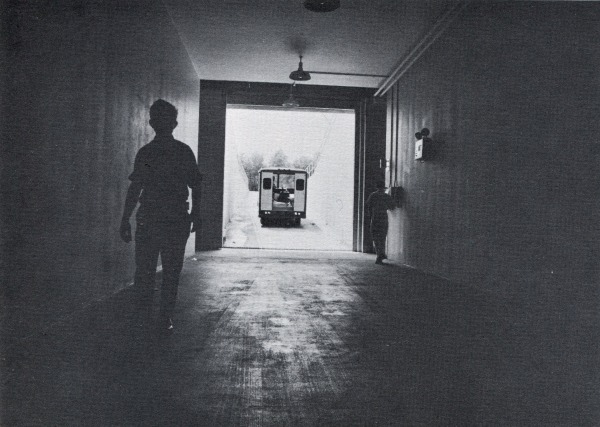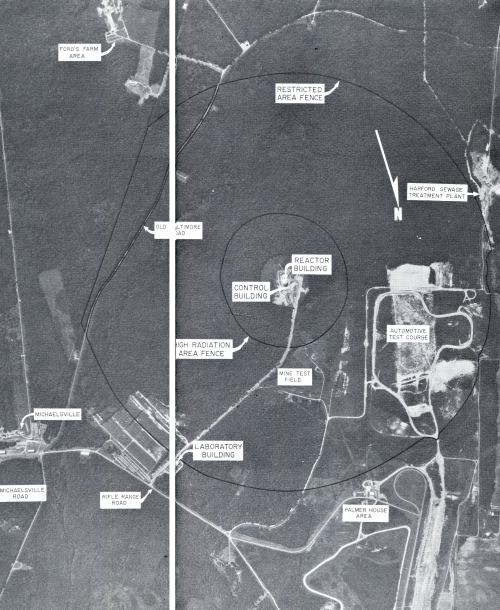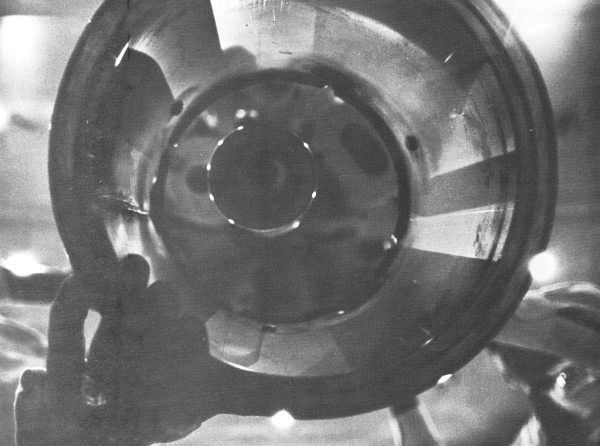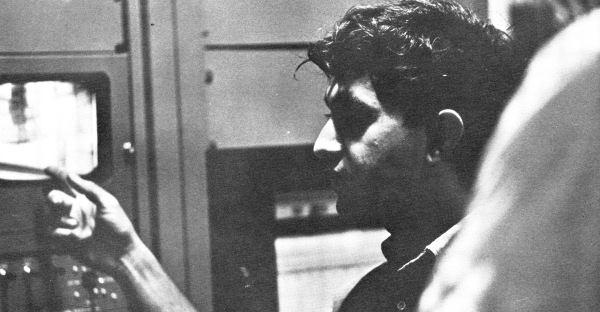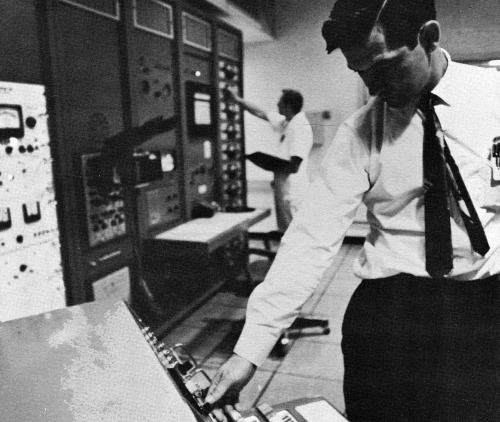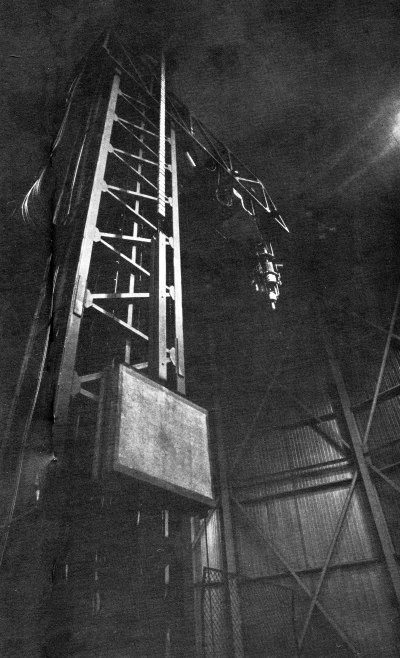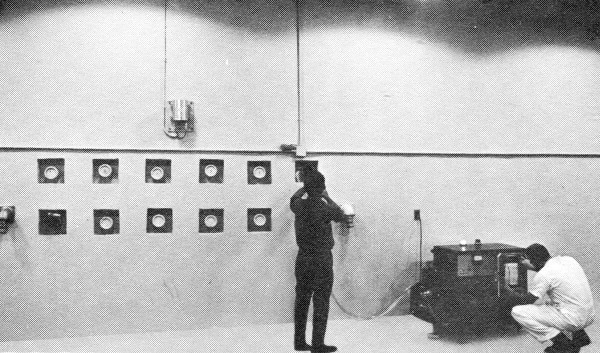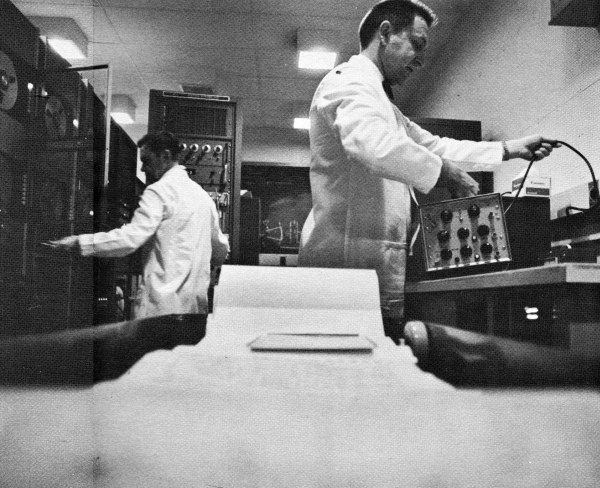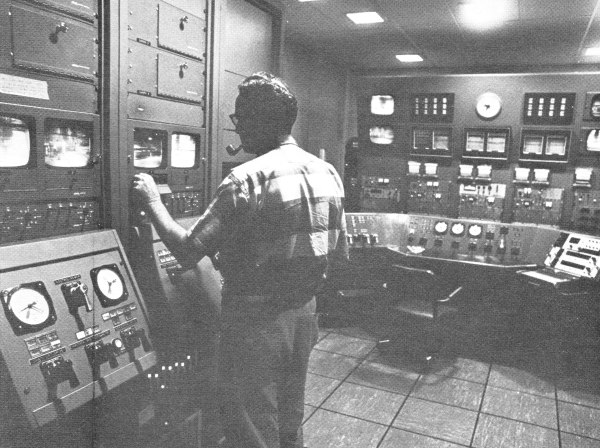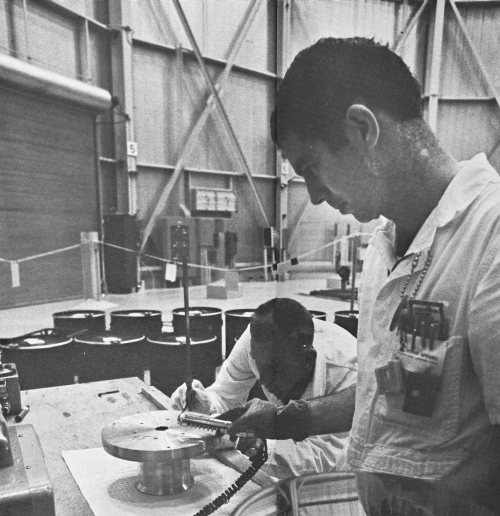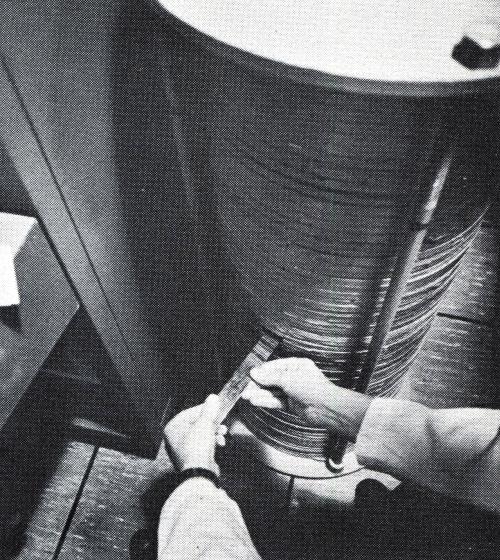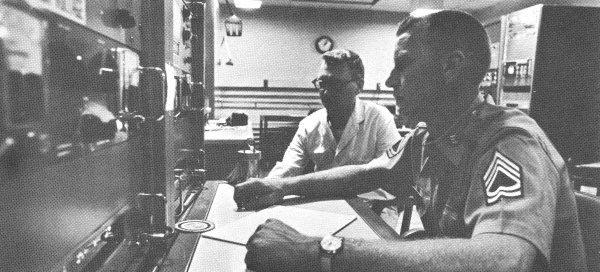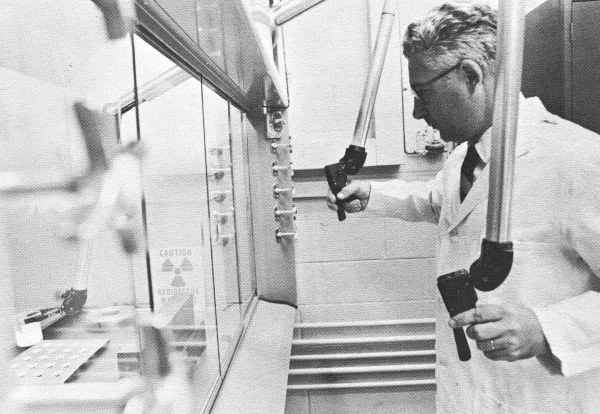The Project Gutenberg eBook of Army Pulse Radiation Facility, by US Army
This eBook is for the use of anyone anywhere in the United States and
most other parts of the world at no cost and with almost no restrictions
whatsoever. You may copy it, give it away or re-use it under the terms
of the Project Gutenberg License included with this eBook or online
at
www.gutenberg.org. If you
are not located in the United States, you will have to check the laws of the
country where you are located before using this eBook.
Title: Army Pulse Radiation Facility
Author: US Army
Release Date: May 18, 2022 [eBook #68120]
Language: English
Produced by: Brian Coe, Lisa Corcoran, who supplied the scans, and the Online Distributed Proofreading Team at https://www.pgdp.net
*** START OF THE PROJECT GUTENBERG EBOOK ARMY PULSE RADIATION FACILITY ***
Army Pulse Radiation Facility
Contents
| |
Page No. |
| The Concept |
3 |
| The Facility |
5 |
| The Reactor |
7 |
| Exposure Locations and Performance Levels |
11 |
| APRF User Support Facilities |
17 |
| Instructions to Potential Users |
20 |
| Table I. |
| APRFR Core Design Data |
8 |
| Table II. |
| Typical APRFR Performance Levels |
8 |
| Table III. |
| APRFR Fluence and Flux Data |
13 |
| Table IV. |
| Nominal APRFR Leakage and U235 Fission Spectra |
13 |
| Table V. |
| Fluence-to-Dose Conversion Factors for APRFR Leakage Neutrons |
14 |
| Table VI. |
| Kerma and Kerma Rate in Tissue for APRFR Exposure Conditions |
14 |
| Table VII. |
| Kerma and Kerma Rate in Silicon for APRFR Exposure Conditions |
15 |
| Table VIII. |
| Neutron-to-Gamma Dose Ratios |
15 |
| Table IX. |
| APRF User Support Equipment |
18 |
Army Pulse Radiation Facility
U.S. Army Ballistic Research Laboratories
AMXRD-BTD
Aberdeen Proving Ground, Maryland 21005
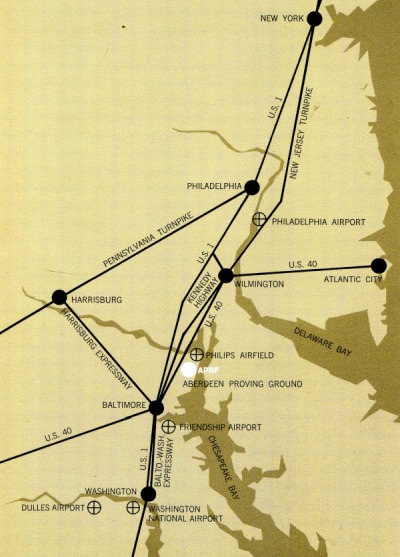
Army Pulse Radiation Facility Location Map
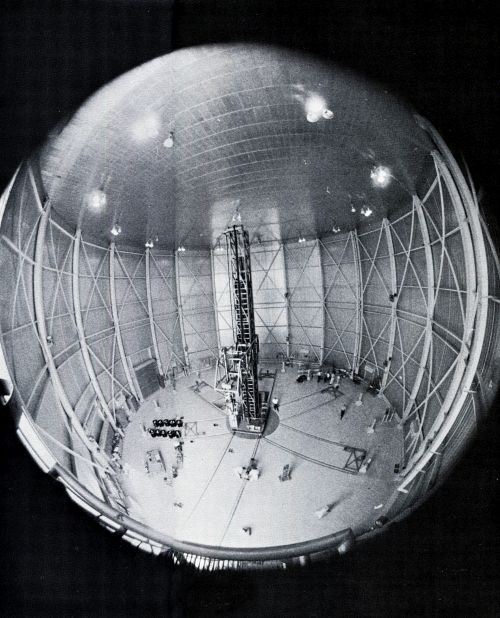
The Army Pulse Radiation Facility (APRF) is designed to meet an
Army need for a facility located near the Eastern Seaboard capable
of providing large fast neutron and gamma radiation doses within
microseconds. This fast pulse radiation capability is necessary for
the determination of transient responses of materiel in nuclear
environments.
The APRF increases Army capability by providing improved simulation of
radiative effects of a nuclear burst for studies of Army interest, and
provides a facility for testing Army materiel. Because of its location,
the APRF economically and efficiently serves the heavy concentration of
Army agencies and contractors located along the Eastern Seaboard.
The design of the APRF is a direct outgrowth of projected user
requirements. Thus the reactor can be used both for high dose
irradiations of small objects, as a point source for radiation detector
studies, and irradiation of bulk objects. The former requirement led
to the incorporation of a 1½-inch OD “glory hole” running through
the center of the core, and providing a fast neutron fluence of
about 9 × 10¹⁴ neutrons per square centimeter per pulse. The latter
two requirements have resulted in the design of a large volume,
low-radiation backscatter Reactor Building. Provision is made for
moving the reactor both within the Reactor Building and to an outdoor
test site at heights variable up to 44 feet above ground by means of a
mechanical device called the reactor transporter. The reactor is also
capable of intermittent steady state operation in the kilowatt range
for classes of experiments requiring this mode of operation.
[Pg 4]
The APRF is located on the military reservation of Aberdeen Proving
Ground (APG), in southeastern Harford County, Maryland. The Reactor
Building is at the center of the facility.
This building is a windowless, circular structure with aluminum siding.
Inside, the building is 100 feet in diameter and 65 feet high. There
is a roll-up door in the south wall for the passage of the reactor
transporter to the outdoor test site and another in the west wall for
the access of vehicles to the building. A shielded stairway and maze
provides access from the underground Control Building. This concrete
structure provides radiological shielding for the personnel and
controls associated with the operation of the reactor and the conduct
of experiments.
The area within a ~450-yard radius of the Reactor Building constitutes
the APRF high-radiation area defined by a 10-foot anti-personnel fence.
This high-radiation area is in turn surrounded by a nearly concentric
restricted area defined at its outer boundary by a barbed wire warning
fence at a radius of ~1500 yards from the Reactor Building.
The Laboratory Building, located at the periphery of the restricted
area, houses the administrative and support personnel for the APRF.
Access to APRF is controlled at this point.
[Pg 6]
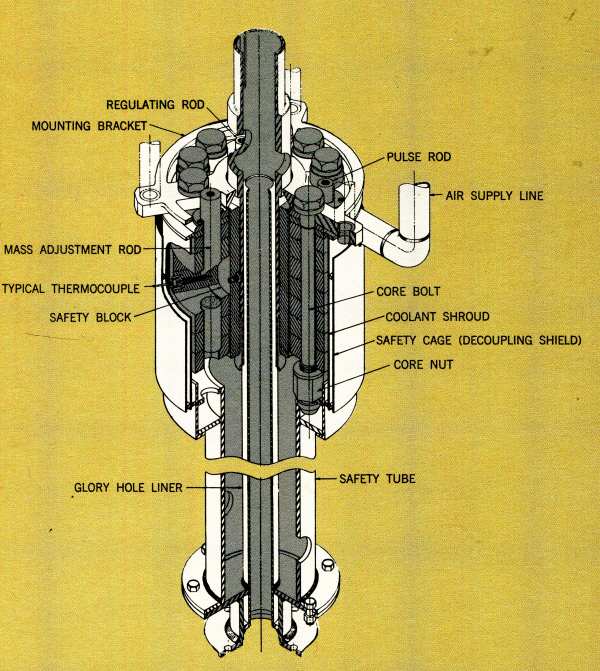
APRF Reactor Core Assembly
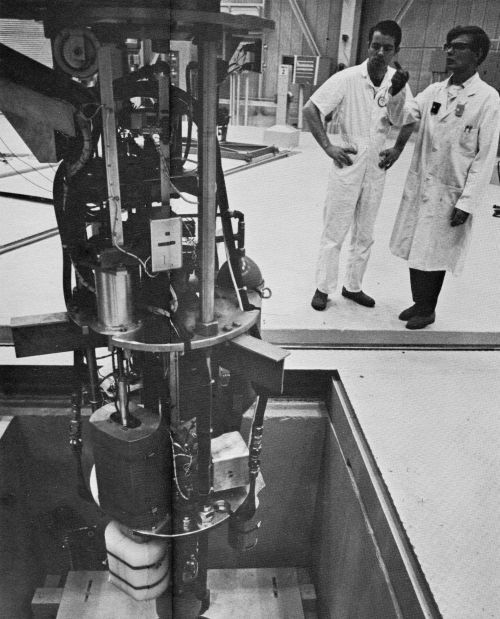
The reactor, (APRFR), is designed for both self-limited,
super-prompt-critical pulse operation and steady state operation. The
maximum available pulse has a yield of ~2.1 × 10¹⁷ fissions, while
steady state operation is limited to about 10 kilowatts by the reactor
core cooling system and activation of the core.
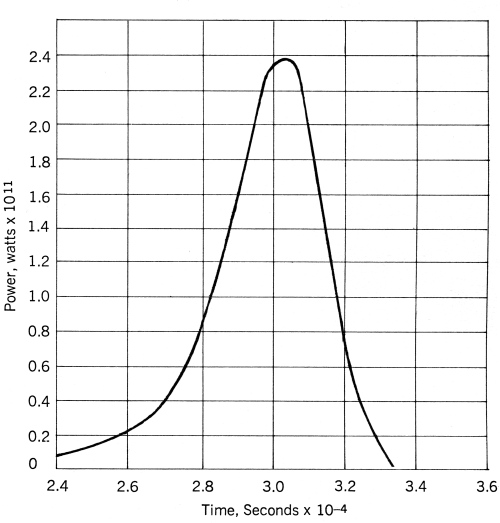
High Yield Prompt Pulse Shape
The APRFR is an advanced version of the Health Physics Research
Reactor (HPRR) at Oak Ridge National Laboratory (ORNL), which has
been operating since 1962. ORNL has played a key role in the design
and testing of the APRFR. In pulse operation, the power level may
rise on periods as short as 10 microseconds. Electro-mechanical scram
systems are too slow to terminate such an excursion. Shutdown results
from increased neutron leakage due to fuel expansion, resulting in
a large prompt negative temperature coefficient of reactivity. This
self-limiting feature depends almost entirely on the thermal expansion
of the fuel alloy, and thus it is regarded as completely reliable and safe.
Following a pulse, additional reactor shutdown capability is provided
by a safety block which, when ejected from the core, reduces the
reactivity to about 20 dollars below delayed-critical. At lower yield
pulses, below about 6 × 10¹⁶ fissions, the safety block is ejected by
[Pg 8]
the electro-mechanical scram system in about 0.1 seconds after a pulse.
At higher yield pulses, the safety block is ejected in much shorter
times due to thermo-mechanical shock forces which cause the safety
block to bounce out. The large shutdown margin provided by the safety
block is also the primary design device for preventing accidental
criticalities during periods of reactor shutdown.
The APRFR core is an unmoderated cylindrical assembly containing about
125 kilograms of an alloy of uranium 235 containing 10% molybdenum. The
actual core mass varies with the experiment. The core is cylindrical
and consists of two concentric annuli: a fixed outer shell of stacked
fuel discs bolted together with nine fuel bolts and Inconel nuts and
a movable inner safety block, also of fuel alloy. The 1½-inch OD
“glory hole” runs vertically through the center of the safety block.
Key reactor data is summarized in Tables I and II. The APRFR has been
operated during tests at ORNL at more than twice its design yield.
Table I.
APRFR Core Design Data
| Core Diameter |
8.90 inches |
| Core Height[1] |
8.0 inches |
| Fuel Alloy |
90 wt % uranium - |
| |
10 wt % molybdenum |
| Uranium-235 Enrichment |
93.14% |
| Total Fuel Mass[2] |
125 |
| Safety Block Mass |
15.7 kg |
| Safety Block Height |
8.06 inches |
| Safety Block Diameter |
4.00 inches |
| Glory Hole Diameter |
1.50 inches |
| Number of Control Rods |
Three |
| Core Cooling |
Forced Air |
| Number of Core Bolts |
Nine |
| Safety Block Reactivity Worth |
~$20 |
| Pulse Rod Reactivity Worth |
~$1.15 |
| Core Environment During Pulse |
Dry Nitrogen |
| Core Cooling |
Forced Air |
Table II.
Typical APRFR Performance Levels
| PULSE MODE |
|
| Routine Yield |
1.5 × 10¹⁷ fissions/pulse |
| Reactivity Insertion |
$1.10 |
| Pulse Half-Width |
48 μsec |
| Initial Prompt Period |
18 μsec |
| Maximum Fuel Temperature Rise |
400°C |
| Temperature Coefficient |
-0.3 cents/°C |
| Maximum Available Yield |
~2.1 × 10¹⁷ fissions/pulse |
| STEADY STATE MODE |
|
| Continuous Operation |
~1 kw |
| Intermittent Operation |
~10 kw |
|
|
|
|
Steady state power levels are
limited by effectiveness of core cooling system and core activation.
[Pg 9]
[Pg 10]
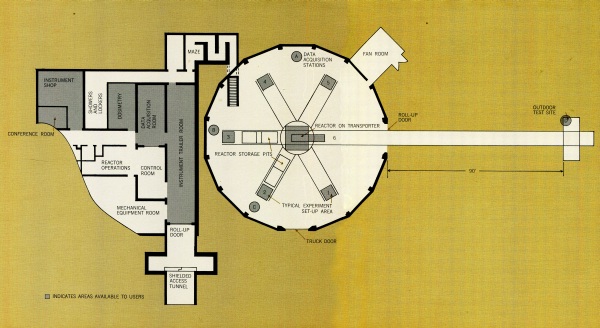
APRF Floor Plan
[Pg 11]
Exposure Locations and Performance Levels
The highest fluence and dose rates are available in the 1½-inch glory
hole. Since the reactor is supported from above by the transporter, the
areas around and below the core are also available for experiments.
The core can be positioned by remote control anywhere within the range
of travel of the transporter. Vertical travel is limited to about 44
feet above the Reactor Building floor level. Horizontal travel is
limited by the range of the rails on which the transporter travels. Six
pairs of rails extend radially from a turntable in the center of the
Reactor Building. These rails terminate within the Reactor Building,
except for one pair which extends 90 feet outside the building to an
outdoor test site. Each pair of rails defines one experimental location
where semi-permanent equipment and shielding can be set up without
tying up the entire reactor operation.
Fluence and flux data for three typical exposure locations are given
in Table III. In the absence of reflecting
material beyond 1 meter from core center (position P3), these values
fall off essentially as
where R is the distance to core center.
Other performance data are summarized in Tables IV through VIII.
[Pg 12]
APRFR Fluence and Flux Data
| |
| |
Routine Pulse Yield
1.5 × 10¹⁷ Fissions |
Maximum Pulse Yield
2.1 × 10¹⁷ Fissions |
| Fluence, n/cm² |
| P1[3] |
6.7 × 10¹⁴ |
9.3 × 10¹⁴ |
| P2 |
2.0 × 10¹⁴ |
2.8 × 10¹⁴ |
| P3 |
1.7 × 10¹² |
2.4 × 10¹² |
| Flux Density, n/cm²/sec |
| P1 |
1.4 × 10¹⁹ |
2.0 × 10¹⁹ |
| P2 |
4.3 × 10¹⁸ |
6.0 × 10¹⁸ |
| P3 |
3.7 × 10¹⁶ |
5.2 × 10¹⁶ |
| |
Table IV.
Nominal APRFR Leakage and U235 Fission Spectra
[4]
| |
Energy
Group
Number
n |
Energy
Range
(Mev) |
Average
Energy
Eₙ
(Mev) |
APRFR
Spectrum
Fraction
XₙΔEₙ |
U235 Fission
Spectrum
Fraction
XₙΔEₙ |
| 1 |
3.0-∞ |
4.41 |
0.133 |
0.204 |
| 2 |
1.4-3.0 |
2.10 |
0.251 |
0.344 |
| 3 |
0.9-1.4 |
1.14 |
0.164 |
0.168 |
| 4 |
0.4-0.9 |
0.65 |
0.262 |
0.180 |
| 5 |
0.1-0.4 |
0.26 |
0.168 |
0.090 |
| 6 |
0-0.1 |
0.059 |
0.022 |
0.014 |
| SUM |
|
|
1.000 |
1.000 |
| Mean |
| Energy |
| (Mev) |
|
|
~1.55 |
~1.8 |
| |
Fluence-to-Dose Conversion Factors
for APRFR Leakage Neutrons
| |
| Material |
Quantity |
Conversion Factor |
| Tissue |
Kerma |
2.4 × 10⁻⁷ |
erg/gram |
| neutron/cm² |
| |
| Tissue |
Maximum Absorbed Dose For |
3.5 × 10⁻⁹ |
rad |
| Normally Incident Neutrons |
neutron/cm² |
| |
| Silicon |
Elastic Recoil Kerma |
2.7 × 10⁻⁹ |
erg/gram |
| (~Permanent Effect) |
neutron/cm² |
| |
| Silicon |
Ionization Kerma |
2.9 × 10⁻⁹ |
erg/gram |
| (~Transient Effects) |
neutron/cm² |
| |
| Silicon |
(Total) Kerma |
5.6 × 10⁻⁹ |
erg/gram |
| |
neutron/cm² |
| |
Table VI.
Kerma and Kerma Rate in Tissue
for APRFR Exposure Conditions
| |
| |
Routine Pulse Yield
1.5 × 10¹⁷ Fissions |
Maximum Pulse Yield
2.1 × 10¹⁷ Fissions |
| Kerma in Tissue (ergs/gm) |
| P1[5] |
1.6 × 10⁸ |
2.2 × 10⁸ |
| P2 |
4.9 × 10⁷ |
6.8 × 10⁷ |
| P3 |
4.1 × 10⁵ |
5.7 × 10⁵ |
| |
| Kerma Rate in Tissue (ergs/gm/sec) |
| P1 |
3.5 × 10¹² |
4.7 × 10¹² |
| P2 |
1.1 × 10¹² |
1.5 × 10¹² |
| P3 |
8.8 × 10⁹ |
1.2 × 10¹⁰ |
| |
Kerma and Kerma Rate in Silicon
for APRFR Exposure Conditions
| |
| |
Routine Pulse Yield
1.5 × 10¹⁷ Fissions |
Maximum Pulse Yield
2.1 × 10¹⁷ Fissions |
| Total Kerma in Silicon, ergs/gm[6] |
| P1[7] |
2.7 × 10⁶ |
5.2 × 10⁶ |
| P2 |
1.1 × 10⁶ |
1.6 × 10⁶ |
| P3 |
9.5 × 10³ |
13.3 × 10³ |
| |
| Total Kerma Rate in Silicon, (ergs/gm/sec) |
| P1 |
5.8 × 10¹⁰ |
11.0 × 10¹⁰ |
| P2 |
2.4 × 10¹⁰ |
3.5 × 10¹⁰ |
| P3 |
2.0 × 10⁸ |
2.9 × 10⁸ |
| |
Table VIII.
Neutron-to-Gamma Dose Ratios
[8]
| |
| |
neutron rads tissue |
|
n/cm²/sec |
| |
gamma rads tissue |
|
gamma rads tissue |
| Core Center (P1) |
10 |
|
2.7 × 10⁹ |
| Core Surface (P2) |
10 |
|
2.7 × 10⁹ |
| 1 Meter from Core Center (P3) |
9 |
|
3.3 × 10⁹ |
| 10 Meters from Core Center |
7 |
|
2.5 × 10⁷ |
| |
[Pg 16]
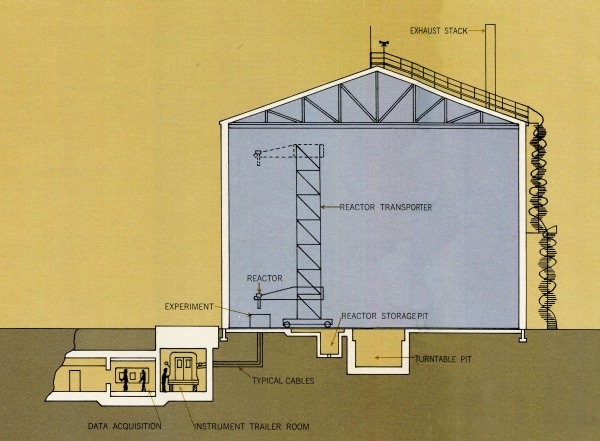
Cross Section of Reactor Building
[Pg 17]
APRF User Support Facilities
APRF is designed and staffed to assist its users in all key areas
relating to reactor utilization.
Physical Space Several areas in the underground Control Building
are available to experimenters. These include the trailer tunnel with
room for two full-sized trailers, the data acquisition room, and the
instrument shop. All of these areas are provided with conduits so that
cables can be run directly to them from the Reactor Building. In the
trailer tunnel the minimum cable length required to run to the core
surface is about 30 feet.
The exposure areas in the Reactor Building and the outdoor test site
are equipped with conduits for communication and instrumentation cables.
Available areas in the Laboratory Building include a high-bay set
up area, a machine shop, laboratory space, fume hood with remote
manipulator, photography laboratory, and offices.
Data Acquisition and Processing The basic element here is the
APRF Data Acquisition System described in Table IX.
Various other instrumentation is available as summarized in
Table IX. Data processing is available at the
ARDC computer center and with on-line equipment at APRF.
Dosimetry Routine dosimetry is performed by APRF personnel.
Methods available include fluence and spectrum measurements using
foil techniques, glass rod microdosimetry, thermoluminescence, and
diverse active dosimeters. Foils are analyzed using the APRF Automatic
Dosimetry System and data are available within a short time following exposure.
Measurements are supplemented by analytical methods including one
and two dimensional transport theory, Monte Carlo, and special foil
analysis codes.
Staff The APRF staff is available to guide, plan and set up
experiments at the reactor, perform dosimetry, and assist in data
acquisition. APRF participation is determined on a case-by-case basis.
Health Physics Health physics survey, monitoring,
decontamination and related services are available in conjunction with
the BRL Health Physics Division.
APRF User Support Equipment
| |
| Transient Data Recording System |
| TAPE RECORDERS: |
Three each—14 track Honeywell Model 7600 |
| FREQUENCY: |
DC to 80 kHz FM, 400 Hz to 700 kHz Direct |
| SIGNAL |
Universal Strain gauge and thermocouple with |
| CONDITIONING: |
100 KC DC amplifiers |
| TIME CODE: |
IRIG A, 1 millisecond resolution |
| PATCH PANELS: |
Coaxial and triaxial connectors for all inputs |
| |
and outputs, insulated shields. |
| AUTO CALIBRATION: |
50 channel, 3 step |
| CHANNEL ID: |
Automatic ID in binary code |
| PLAYBACK: |
12” oscillograph |
| Dosimetry |
| Basic Foil Calibration System |
| 5000 Curie Co-60 source |
| Automated Sulfur, Fission Foil and Gamma Well Counting System, |
| 100 Samples each per cycle |
| Eight channel active dosimeter system with digital read out and |
| computer analysis of neutron fluence and energy |
| Toshiba Glass Rod and Harshaw TLD Gamma System |
| Computer |
| 16 bit/16K memory with foreground/background operation. Automatic |
| acquisition and reduction of foil counting data on-line. On-line |
| monitoring of reactor power pulse with analysis of peak, half-width |
| and yield. On-line monitoring of active dosimeters with data reduction. |
| Real time/Fortran IV. |
| General Equipment |
| 3300 Nuclear Data Multiparameter Analyzer, 4096 channel with |
| magnetic tape; RIDL 400 Channel Pulse Height Analyzer. |
| Oscilloscopes, cameras, electronic calibration equipment. |
| Hood areas with manipulators, photographic laboratory, radiation |
| monitoring equipment and services, machine shop. |
| |
[Pg 19]
[Pg 20]
Instructions To Potential Users
It is imperative to realize that there are stringent safety
requirements connected with the use of the APRFR. All experiments will
follow a written test plan approved at APRF. In order to perform an
experiment with maximum usefulness and efficiency, it is essential
that APRF be contacted during the early planning stages of a potential
experiment. Failure to do this may result in erroneous experiment
planning as regards safety and use of exposure space resulting in schedule
delays, and possibly cancellation or drastic revision of the experiment.
For further information contact:
Commanding Officer
U.S. Army Ballistic Research Laboratories
ATTN: AMXRD-BTD, Facility Coordinator
Aberdeen Proving Ground, Maryland 21005
Transcriber’s Notes:
The illustrations have been moved so that they do not break up
paragraphs and so that they are next to the text they illustrate.
Typographical and punctuation errors have been silently corrected.
*** END OF THE PROJECT GUTENBERG EBOOK ARMY PULSE RADIATION FACILITY ***
Updated editions will replace the previous one—the old editions will
be renamed.
Creating the works from print editions not protected by U.S. copyright
law means that no one owns a United States copyright in these works,
so the Foundation (and you!) can copy and distribute it in the United
States without permission and without paying copyright
royalties. Special rules, set forth in the General Terms of Use part
of this license, apply to copying and distributing Project
Gutenberg™ electronic works to protect the PROJECT GUTENBERG™
concept and trademark. Project Gutenberg is a registered trademark,
and may not be used if you charge for an eBook, except by following
the terms of the trademark license, including paying royalties for use
of the Project Gutenberg trademark. If you do not charge anything for
copies of this eBook, complying with the trademark license is very
easy. You may use this eBook for nearly any purpose such as creation
of derivative works, reports, performances and research. Project
Gutenberg eBooks may be modified and printed and given away—you may
do practically ANYTHING in the United States with eBooks not protected
by U.S. copyright law. Redistribution is subject to the trademark
license, especially commercial redistribution.
START: FULL LICENSE
THE FULL PROJECT GUTENBERG LICENSE
PLEASE READ THIS BEFORE YOU DISTRIBUTE OR USE THIS WORK
To protect the Project Gutenberg™ mission of promoting the free
distribution of electronic works, by using or distributing this work
(or any other work associated in any way with the phrase “Project
Gutenberg”), you agree to comply with all the terms of the Full
Project Gutenberg™ License available with this file or online at
www.gutenberg.org/license.
Section 1. General Terms of Use and Redistributing Project Gutenberg™ electronic works
1.A. By reading or using any part of this Project Gutenberg™
electronic work, you indicate that you have read, understand, agree to
and accept all the terms of this license and intellectual property
(trademark/copyright) agreement. If you do not agree to abide by all
the terms of this agreement, you must cease using and return or
destroy all copies of Project Gutenberg™ electronic works in your
possession. If you paid a fee for obtaining a copy of or access to a
Project Gutenberg™ electronic work and you do not agree to be bound
by the terms of this agreement, you may obtain a refund from the person
or entity to whom you paid the fee as set forth in paragraph 1.E.8.
1.B. “Project Gutenberg” is a registered trademark. It may only be
used on or associated in any way with an electronic work by people who
agree to be bound by the terms of this agreement. There are a few
things that you can do with most Project Gutenberg™ electronic works
even without complying with the full terms of this agreement. See
paragraph 1.C below. There are a lot of things you can do with Project
Gutenberg™ electronic works if you follow the terms of this
agreement and help preserve free future access to Project Gutenberg™
electronic works. See paragraph 1.E below.
1.C. The Project Gutenberg Literary Archive Foundation (“the
Foundation” or PGLAF), owns a compilation copyright in the collection
of Project Gutenberg™ electronic works. Nearly all the individual
works in the collection are in the public domain in the United
States. If an individual work is unprotected by copyright law in the
United States and you are located in the United States, we do not
claim a right to prevent you from copying, distributing, performing,
displaying or creating derivative works based on the work as long as
all references to Project Gutenberg are removed. Of course, we hope
that you will support the Project Gutenberg™ mission of promoting
free access to electronic works by freely sharing Project Gutenberg™
works in compliance with the terms of this agreement for keeping the
Project Gutenberg™ name associated with the work. You can easily
comply with the terms of this agreement by keeping this work in the
same format with its attached full Project Gutenberg™ License when
you share it without charge with others.
1.D. The copyright laws of the place where you are located also govern
what you can do with this work. Copyright laws in most countries are
in a constant state of change. If you are outside the United States,
check the laws of your country in addition to the terms of this
agreement before downloading, copying, displaying, performing,
distributing or creating derivative works based on this work or any
other Project Gutenberg™ work. The Foundation makes no
representations concerning the copyright status of any work in any
country other than the United States.
1.E. Unless you have removed all references to Project Gutenberg:
1.E.1. The following sentence, with active links to, or other
immediate access to, the full Project Gutenberg™ License must appear
prominently whenever any copy of a Project Gutenberg™ work (any work
on which the phrase “Project Gutenberg” appears, or with which the
phrase “Project Gutenberg” is associated) is accessed, displayed,
performed, viewed, copied or distributed:
This eBook is for the use of anyone anywhere in the United States and most
other parts of the world at no cost and with almost no restrictions
whatsoever. You may copy it, give it away or re-use it under the terms
of the Project Gutenberg License included with this eBook or online
at
www.gutenberg.org. If you
are not located in the United States, you will have to check the laws
of the country where you are located before using this eBook.
1.E.2. If an individual Project Gutenberg™ electronic work is
derived from texts not protected by U.S. copyright law (does not
contain a notice indicating that it is posted with permission of the
copyright holder), the work can be copied and distributed to anyone in
the United States without paying any fees or charges. If you are
redistributing or providing access to a work with the phrase “Project
Gutenberg” associated with or appearing on the work, you must comply
either with the requirements of paragraphs 1.E.1 through 1.E.7 or
obtain permission for the use of the work and the Project Gutenberg™
trademark as set forth in paragraphs 1.E.8 or 1.E.9.
1.E.3. If an individual Project Gutenberg™ electronic work is posted
with the permission of the copyright holder, your use and distribution
must comply with both paragraphs 1.E.1 through 1.E.7 and any
additional terms imposed by the copyright holder. Additional terms
will be linked to the Project Gutenberg™ License for all works
posted with the permission of the copyright holder found at the
beginning of this work.
1.E.4. Do not unlink or detach or remove the full Project Gutenberg™
License terms from this work, or any files containing a part of this
work or any other work associated with Project Gutenberg™.
1.E.5. Do not copy, display, perform, distribute or redistribute this
electronic work, or any part of this electronic work, without
prominently displaying the sentence set forth in paragraph 1.E.1 with
active links or immediate access to the full terms of the Project
Gutenberg™ License.
1.E.6. You may convert to and distribute this work in any binary,
compressed, marked up, nonproprietary or proprietary form, including
any word processing or hypertext form. However, if you provide access
to or distribute copies of a Project Gutenberg™ work in a format
other than “Plain Vanilla ASCII” or other format used in the official
version posted on the official Project Gutenberg™ website
(www.gutenberg.org), you must, at no additional cost, fee or expense
to the user, provide a copy, a means of exporting a copy, or a means
of obtaining a copy upon request, of the work in its original “Plain
Vanilla ASCII” or other form. Any alternate format must include the
full Project Gutenberg™ License as specified in paragraph 1.E.1.
1.E.7. Do not charge a fee for access to, viewing, displaying,
performing, copying or distributing any Project Gutenberg™ works
unless you comply with paragraph 1.E.8 or 1.E.9.
1.E.8. You may charge a reasonable fee for copies of or providing
access to or distributing Project Gutenberg™ electronic works
provided that:
• You pay a royalty fee of 20% of the gross profits you derive from
the use of Project Gutenberg™ works calculated using the method
you already use to calculate your applicable taxes. The fee is owed
to the owner of the Project Gutenberg™ trademark, but he has
agreed to donate royalties under this paragraph to the Project
Gutenberg Literary Archive Foundation. Royalty payments must be paid
within 60 days following each date on which you prepare (or are
legally required to prepare) your periodic tax returns. Royalty
payments should be clearly marked as such and sent to the Project
Gutenberg Literary Archive Foundation at the address specified in
Section 4, “Information about donations to the Project Gutenberg
Literary Archive Foundation.”
• You provide a full refund of any money paid by a user who notifies
you in writing (or by e-mail) within 30 days of receipt that s/he
does not agree to the terms of the full Project Gutenberg™
License. You must require such a user to return or destroy all
copies of the works possessed in a physical medium and discontinue
all use of and all access to other copies of Project Gutenberg™
works.
• You provide, in accordance with paragraph 1.F.3, a full refund of
any money paid for a work or a replacement copy, if a defect in the
electronic work is discovered and reported to you within 90 days of
receipt of the work.
• You comply with all other terms of this agreement for free
distribution of Project Gutenberg™ works.
1.E.9. If you wish to charge a fee or distribute a Project
Gutenberg™ electronic work or group of works on different terms than
are set forth in this agreement, you must obtain permission in writing
from the Project Gutenberg Literary Archive Foundation, the manager of
the Project Gutenberg™ trademark. Contact the Foundation as set
forth in Section 3 below.
1.F.
1.F.1. Project Gutenberg volunteers and employees expend considerable
effort to identify, do copyright research on, transcribe and proofread
works not protected by U.S. copyright law in creating the Project
Gutenberg™ collection. Despite these efforts, Project Gutenberg™
electronic works, and the medium on which they may be stored, may
contain “Defects,” such as, but not limited to, incomplete, inaccurate
or corrupt data, transcription errors, a copyright or other
intellectual property infringement, a defective or damaged disk or
other medium, a computer virus, or computer codes that damage or
cannot be read by your equipment.
1.F.2. LIMITED WARRANTY, DISCLAIMER OF DAMAGES - Except for the “Right
of Replacement or Refund” described in paragraph 1.F.3, the Project
Gutenberg Literary Archive Foundation, the owner of the Project
Gutenberg™ trademark, and any other party distributing a Project
Gutenberg™ electronic work under this agreement, disclaim all
liability to you for damages, costs and expenses, including legal
fees. YOU AGREE THAT YOU HAVE NO REMEDIES FOR NEGLIGENCE, STRICT
LIABILITY, BREACH OF WARRANTY OR BREACH OF CONTRACT EXCEPT THOSE
PROVIDED IN PARAGRAPH 1.F.3. YOU AGREE THAT THE FOUNDATION, THE
TRADEMARK OWNER, AND ANY DISTRIBUTOR UNDER THIS AGREEMENT WILL NOT BE
LIABLE TO YOU FOR ACTUAL, DIRECT, INDIRECT, CONSEQUENTIAL, PUNITIVE OR
INCIDENTAL DAMAGES EVEN IF YOU GIVE NOTICE OF THE POSSIBILITY OF SUCH
DAMAGE.
1.F.3. LIMITED RIGHT OF REPLACEMENT OR REFUND - If you discover a
defect in this electronic work within 90 days of receiving it, you can
receive a refund of the money (if any) you paid for it by sending a
written explanation to the person you received the work from. If you
received the work on a physical medium, you must return the medium
with your written explanation. The person or entity that provided you
with the defective work may elect to provide a replacement copy in
lieu of a refund. If you received the work electronically, the person
or entity providing it to you may choose to give you a second
opportunity to receive the work electronically in lieu of a refund. If
the second copy is also defective, you may demand a refund in writing
without further opportunities to fix the problem.
1.F.4. Except for the limited right of replacement or refund set forth
in paragraph 1.F.3, this work is provided to you ‘AS-IS’, WITH NO
OTHER WARRANTIES OF ANY KIND, EXPRESS OR IMPLIED, INCLUDING BUT NOT
LIMITED TO WARRANTIES OF MERCHANTABILITY OR FITNESS FOR ANY PURPOSE.
1.F.5. Some states do not allow disclaimers of certain implied
warranties or the exclusion or limitation of certain types of
damages. If any disclaimer or limitation set forth in this agreement
violates the law of the state applicable to this agreement, the
agreement shall be interpreted to make the maximum disclaimer or
limitation permitted by the applicable state law. The invalidity or
unenforceability of any provision of this agreement shall not void the
remaining provisions.
1.F.6. INDEMNITY - You agree to indemnify and hold the Foundation, the
trademark owner, any agent or employee of the Foundation, anyone
providing copies of Project Gutenberg™ electronic works in
accordance with this agreement, and any volunteers associated with the
production, promotion and distribution of Project Gutenberg™
electronic works, harmless from all liability, costs and expenses,
including legal fees, that arise directly or indirectly from any of
the following which you do or cause to occur: (a) distribution of this
or any Project Gutenberg™ work, (b) alteration, modification, or
additions or deletions to any Project Gutenberg™ work, and (c) any
Defect you cause.
Section 2. Information about the Mission of Project Gutenberg™
Project Gutenberg™ is synonymous with the free distribution of
electronic works in formats readable by the widest variety of
computers including obsolete, old, middle-aged and new computers. It
exists because of the efforts of hundreds of volunteers and donations
from people in all walks of life.
Volunteers and financial support to provide volunteers with the
assistance they need are critical to reaching Project Gutenberg™’s
goals and ensuring that the Project Gutenberg™ collection will
remain freely available for generations to come. In 2001, the Project
Gutenberg Literary Archive Foundation was created to provide a secure
and permanent future for Project Gutenberg™ and future
generations. To learn more about the Project Gutenberg Literary
Archive Foundation and how your efforts and donations can help, see
Sections 3 and 4 and the Foundation information page at www.gutenberg.org.
Section 3. Information about the Project Gutenberg Literary Archive Foundation
The Project Gutenberg Literary Archive Foundation is a non-profit
501(c)(3) educational corporation organized under the laws of the
state of Mississippi and granted tax exempt status by the Internal
Revenue Service. The Foundation’s EIN or federal tax identification
number is 64-6221541. Contributions to the Project Gutenberg Literary
Archive Foundation are tax deductible to the full extent permitted by
U.S. federal laws and your state’s laws.
The Foundation’s business office is located at 809 North 1500 West,
Salt Lake City, UT 84116, (801) 596-1887. Email contact links and up
to date contact information can be found at the Foundation’s website
and official page at www.gutenberg.org/contact
Section 4. Information about Donations to the Project Gutenberg Literary Archive Foundation
Project Gutenberg™ depends upon and cannot survive without widespread
public support and donations to carry out its mission of
increasing the number of public domain and licensed works that can be
freely distributed in machine-readable form accessible by the widest
array of equipment including outdated equipment. Many small donations
($1 to $5,000) are particularly important to maintaining tax exempt
status with the IRS.
The Foundation is committed to complying with the laws regulating
charities and charitable donations in all 50 states of the United
States. Compliance requirements are not uniform and it takes a
considerable effort, much paperwork and many fees to meet and keep up
with these requirements. We do not solicit donations in locations
where we have not received written confirmation of compliance. To SEND
DONATIONS or determine the status of compliance for any particular state
visit
www.gutenberg.org/donate.
While we cannot and do not solicit contributions from states where we
have not met the solicitation requirements, we know of no prohibition
against accepting unsolicited donations from donors in such states who
approach us with offers to donate.
International donations are gratefully accepted, but we cannot make
any statements concerning tax treatment of donations received from
outside the United States. U.S. laws alone swamp our small staff.
Please check the Project Gutenberg web pages for current donation
methods and addresses. Donations are accepted in a number of other
ways including checks, online payments and credit card donations. To
donate, please visit: www.gutenberg.org/donate
Section 5. General Information About Project Gutenberg™ electronic works
Professor Michael S. Hart was the originator of the Project
Gutenberg™ concept of a library of electronic works that could be
freely shared with anyone. For forty years, he produced and
distributed Project Gutenberg™ eBooks with only a loose network of
volunteer support.
Project Gutenberg™ eBooks are often created from several printed
editions, all of which are confirmed as not protected by copyright in
the U.S. unless a copyright notice is included. Thus, we do not
necessarily keep eBooks in compliance with any particular paper
edition.
Most people start at our website which has the main PG search
facility:
www.gutenberg.org.
This website includes information about Project Gutenberg™,
including how to make donations to the Project Gutenberg Literary
Archive Foundation, how to help produce our new eBooks, and how to
subscribe to our email newsletter to hear about new eBooks.





